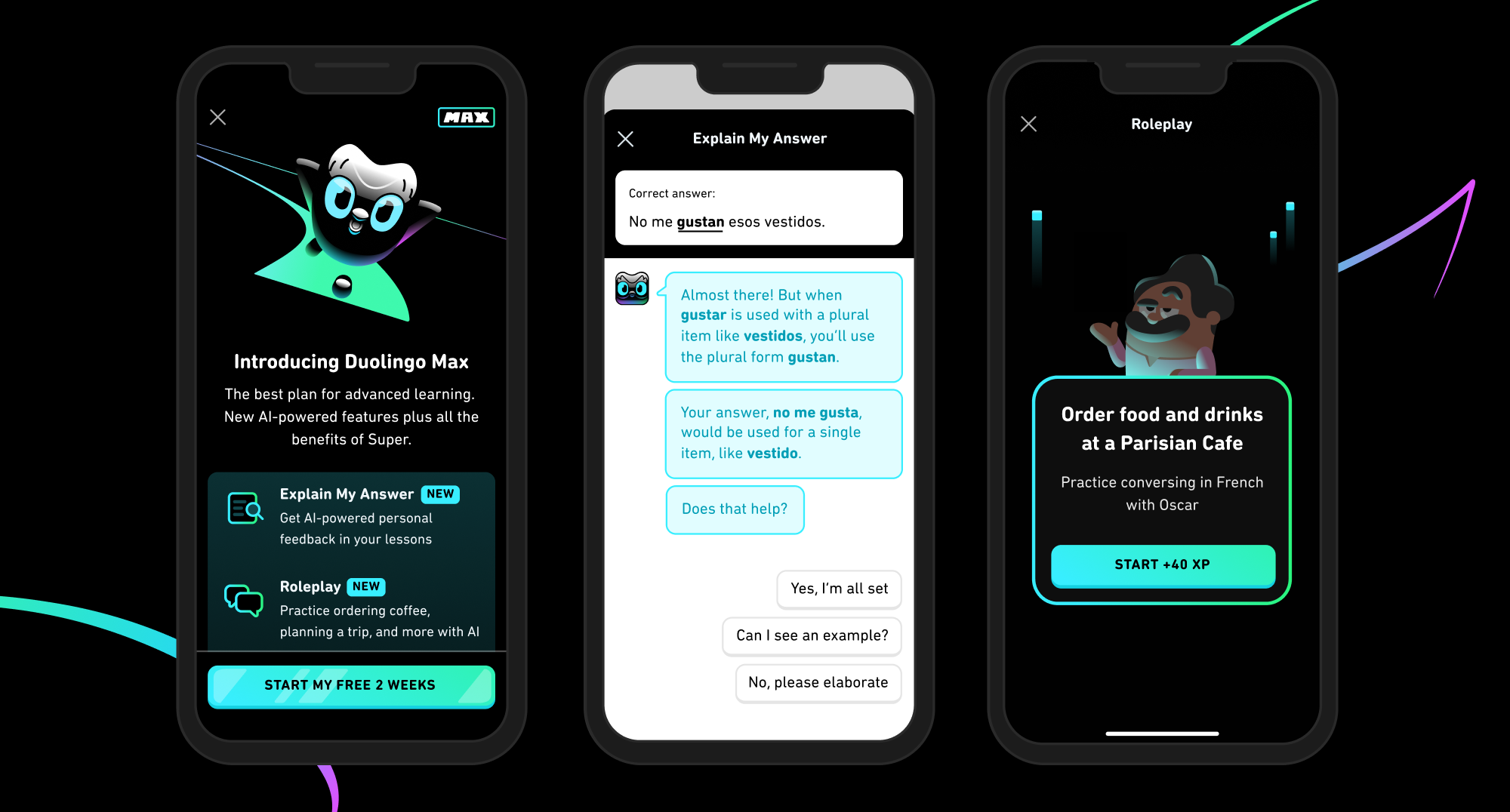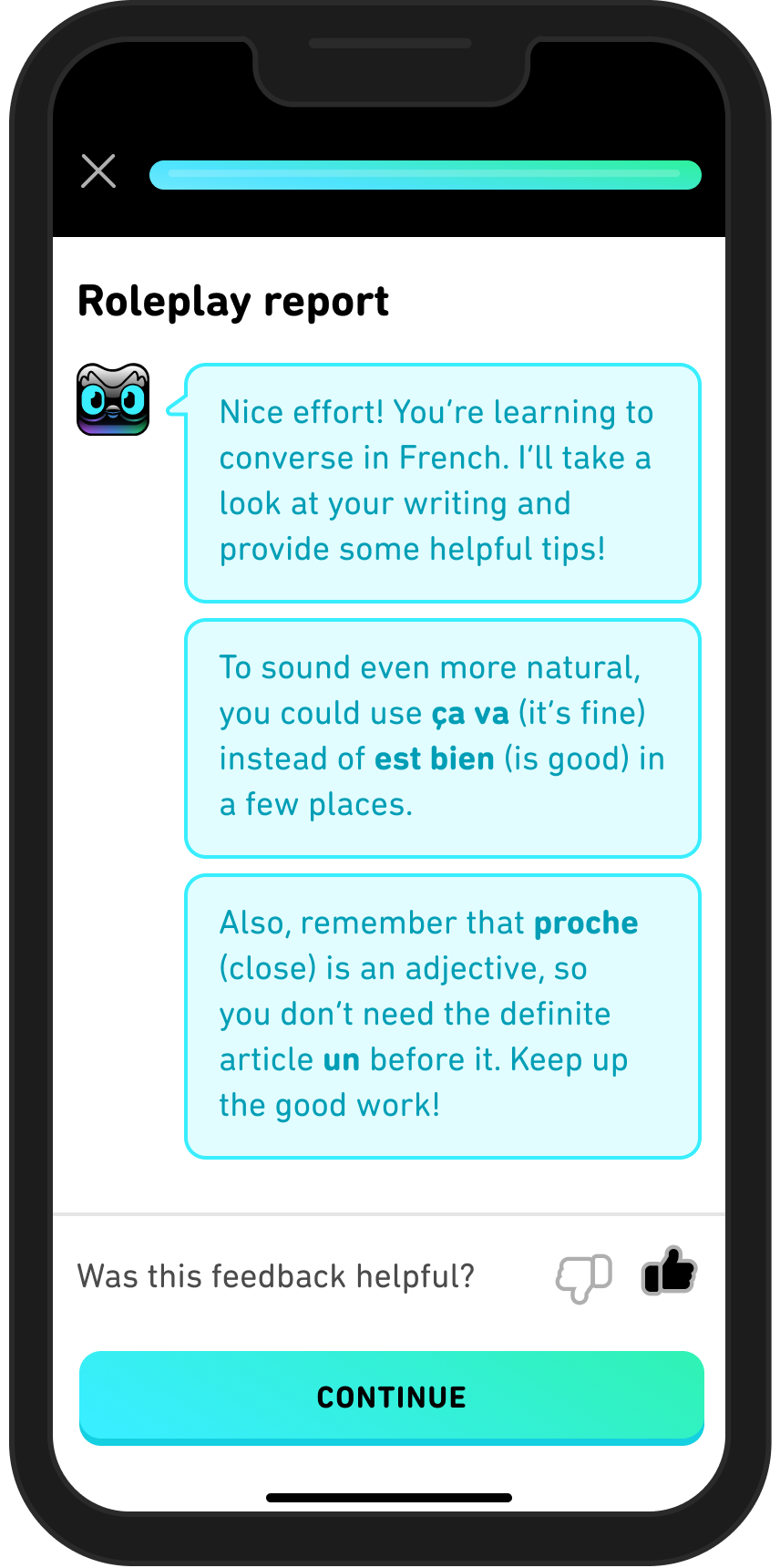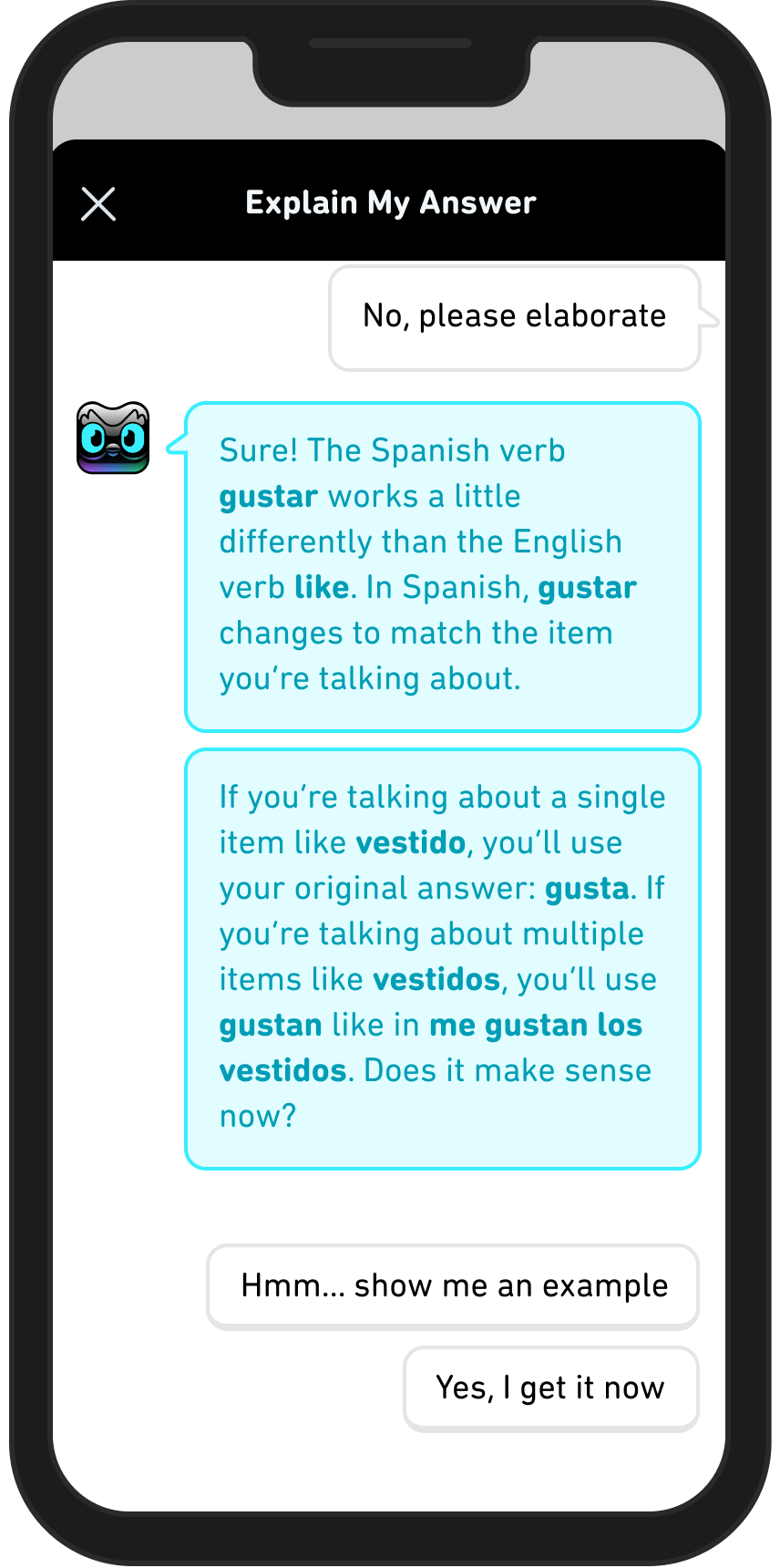What is Duolingo Max? The GPT-4 Powered Learning Tool Explained by The App’s Product Manager
Duolingo Max uses GPT-4 and the ChatGPT technology allows for text- or voice-based conversations and detailed explanations of question answers.

Duolingo Max incorporates GPT-4 technology into existing Duolingo features to allow users a more interactive experience, says Edwin Bodge, Senior Product Manager at Duolingo.
GPT-4 does this by powering two new features for Duolingo Max: Explain My Answer and Roleplay.
“Both these features are a great step toward our vision or dream of allowing Duolingo Max to be more like a human tutor in your pocket,” Bodge says.
Duolingo is one the globe’s most popular edtech apps. GPT-4 was recently unveiled by OpenAI and is the most advanced version of the large language model that powers ChatGPT and is now being used to power ChatGPT Plus and other apps, including Khanmigo, a learning assistant being piloted by Khan Academy.
In addition to speaking with Bodge, I had the opportunity to use Duolingo Max and was impressed. It’s more subtle than other applications of GPT-4 I’ve seen while still being effective. It is even helping me make some small strides in my attempts to learn Spanish, though mi español es muy pobre.
Read on for everything you need to know about Duolingo Max.
What is Duolingo Max?

Duolingo Max utilizes GPT-4 AI technology to allow users to interact with a virtual language tutor via Roleplay, and to get detailed feedback on the rules around questions they got right or wrong through the Explain My Answer feature. It is currently only available in Spanish and French courses but eventually will be expanded to other languages.
Tools and ideas to transform education. Sign up below.
Duolingo users have long requested more feedback about their answers to existing quizzes in the app, and GPT-4 can do that by quickly analyzing what users got right and wrong and generating detailed explanations. “We're able to send a lot of context to GPT-4 and say, ‘Here's what they got wrong. Here's what it should have been, and here's kind of what they were trying to do,’” Bodge says. “And then it's able to give a really nice, concise, factual explanation of what the rules are, and not only just what the rules are, but how they apply very specifically.”
What I found particularly helpful is this feature’s ability to explain the same concept in multiple ways by utilizing different examples or explanations that were generated on demand. As any educator knows, it can take hearing the same thing explained in different ways for new knowledge to click.
Duolingo users have also asked for the type of situational practice Duolingo Max now offers through the Roleplay feature. “They want to learn their language with vocab and grammar, but then they have to go use it somewhere,” Bodge says. “GPT-4 has unlocked the ability for us to create these conversations that they can immerse themselves in. For instance, maybe they are learning Spanish because they want to travel to Barcelona. So we can say, 'Hey, you're now in a cafe in Barcelona, go and have this conversation back and forth,’ to actually simulate what it's like to use your language in real life.”
At the end of the session, the app will summarize how you did, and provide feedback and suggestions for what you could have s
What Does Duolingo Max Cost?

Duolingo Max costs $30 per month or $168 annually. It is a new tier of subscription above Super Duolingo, which costs $7 per month. The free version of Duolingo is also available.
Running GPT-4 requires such intense computing power that access to it is expensive currently, but many in the industry hope those costs will soon come down.
Bodge believes GPT-4 technology will ultimately increase access to language education. “We think it's going to actually be great for equity in terms of being able to deliver these experiences to more and more of our learners over time,” he says. “Of course, we're constrained right now because OpenAI has a cost to it. Over time, we do want to find ways to bring this technology into more facets of the product, whether that be the free experience or the school experience.”
He adds that many students don’t have language teachers at all, and even for those who do, the teacher can’t always be there. GPT-4 is allowing Duolingo to fill in those gaps more effectively. “You're able to have these experiences that better replicate that experience of having a human tutor looking over your shoulder and actually helping you with these things,” he says.
How Did This Collaboration Come About?
Prior to the launch of Duolingo Max, Duolingo had long incorporated AI technology into its apps and has had a relationship with OpenAI since 2019. GPT-3, a precursor to the GPT-3.5-powered ChatGPT, has been utilized by Duolingo for several years now and one of its main functions is to provide feedback on writing within the app.
“GPT-3 was good enough to go in and make those edits,” Bodge says. However, the company tried developing a chatbot with GPT-3 that could interact with students and the technology wasn’t quite ready for that as it could be inaccurate in its responses.
“GPT-4 is so much more accurate that the accuracy rates are high enough that we're comfortable putting this in front of learners,” Bodge says. “The really hard thing, especially with language learning, is you're trying to have them have the conversation in another language and you have all these constraints. Like they're in a cafe in Barcelona, so make it culturally relevant. They also are a beginner, they only know very minimal vocabulary or grammar, so only use those concepts. And then also it's Duolingo. So we want to make it fun. So it's like, also make it goofy and quirky.”
Will The Chatbot Say Weird Things As AI Sometimes Does?
While some AI models have famously gone off the rails, Bodge says Duolingo Max has safeguards against that. “The first one is we're in a much more contained space,” Bodge says. “The bot thinks it's in a cafe. So it's a lot less likely inherently to go off and think about these more ‘out there’ questions. The other two things that we do are that we have another AI model on top of the learner's input. This is a model that we've trained alongside OpenAI and it basically does moderation for us. So if you put in something that's either off-topic or flagrant or misleading, and trying to get the bot to go off-topic, it's a very smart AI model that is able to say, 'This feels off-topic. Let's try again,’ and it asks the learner to type in the response again.’”
If something were to slip by this second AI model, the Duolingo Max GPT-4 chatbot has also been programmed to steer the conversation back to language learning topics.
What is It Like Using Duolingo Max?
Using Duolingo Max’s GPT tools is interesting because it is much more contained and focused than other applications of GPT-4 I’ve explored. As such, there’s a little less wow factor. On the other hand, it is a step forward in the already interactive app.
Explain My Answer provides more context and can generate different examples if you don’t understand the first one, which is something a good real-life teacher always does. Roleplay also allows for much more real-life practice. You can type or speak responses to spoken questions, though the conversation is a little slower than one might be with an actual tutor. For a beginner such as me, that shows just how far I have to go to be able actually to converse in Spanish, but I’ve been impressed by how it pulls me along bit-by-bit and has built-in tips to keep things moving even when I’m clearly a little out of my element.
My impression is this would be a highly beneficial tool to more advanced language learners who are looking to test the limits of their existing vocabulary.
If you’re able to work with a human teacher in addition to the Duolingo app, that currently can give you extra benefits, Bodge says. The goal is for the app to continue to develop many of the skills a good language tutor would bring to the table. “There's still some things that we want to tackle, but we've made a really, really big step in that direction,” he says.
After exploring the capabilities of Duolingo Max, I have to agree.
- Does Duolingo Work?
- What Is Khanmigo? The GPT-4 Learning Tool Explained by Sal Khan
- What Is Duolingo And How Does It Work? Tips & Tricks
- What is Duolingo Math and How Can It Be Used to Teach? Tips & Tricks
To share your feedback and ideas on this article, consider joining our Tech & Learning online community here
Erik Ofgang is a Tech & Learning contributor. A journalist, author and educator, his work has appeared in The New York Times, the Washington Post, the Smithsonian, The Atlantic, and Associated Press. He currently teaches at Western Connecticut State University’s MFA program. While a staff writer at Connecticut Magazine he won a Society of Professional Journalism Award for his education reporting. He is interested in how humans learn and how technology can make that more effective.

